It’s hard to see at first. The old airport sitting out by itself, between Newberry Springs and Daggett. Like many places in our desert, it’s too tough to disappear, and has a story to tell. Just off Interstate 40 at the Hidden Springs exit 12 miles east of Barstow, then north beyond the railroad tracks, Barstow-Daggett Airport is a place where the past shares a symbiosis with the future.
Originally built in 1933 as a Civil Aeronautics Administration beacon site to help pilots navigate, long before the advent of modern aids such as GPS, it ranks as the oldest of the six airports currently operated by San Bernardino County.
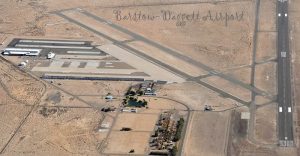
During World War 2, the United States Army Air Force established numerous airfields in California for training pilots and aircrews of fighters and bombers. With millions of acres of open land, there was no place better than the desert to hone the skills that helped win the war. Daggett Municipal Airport, as Barstow-Daggett was known at the time, did its part.
On 4 May 1942 the Federal Government made an agreement with San Bernardino County to lease 1,099-acres site and operate it as a Modification Center for the Douglas A-20 Havoc bomber aircraft that were then sent to our allies in the Soviet Union. In November of the same year, Standard Oil installed a lubricating oil storage and distribution facilities at the site.

The workforce at the airport increased virtually overnight. With no local housing available, save a few places in Daggett, it was necessary to build them in place. On 28 March 1943, a $350,000 housing project was authorized to provide living quarters for 350 Douglas Aircraft workers.
As the war continued, Daggett Airport was used by 444th Air Base Group to support P-38 Units coming in for air to ground rocket training. Later, it was the home of the Fourth Air Force, tasked with the air defense of the West Coast.
About 65 buildings and 20 other structures were built at the facility (headquarters and flight operations buildings, hangars, barracks, sewage treatment plants, warehouses, water wells, water and fuel storage tanks, gasoline station, and even a swimming pool. It had all the fixings of a regular military base.
After April 1944, operational training was changed to replacement training of newly commissioned pilots in combat fighters from the AAF Training Command advanced flying schools. Then, as fast as it grew up, it was suddenly over.
All 1,099 acres was classified as surplus on 15 November 1945. Custody and accountability for the site was assumed by the War Assets Administration on 27 June 1946, with the installation immediately transferred to the Navy Department.

According to airport personnel interviewed during the site visit, the County obtained control of facility from the military in 1958. Unfortunately, a fire during the 1960s destroyed County records of the transaction.
During 1946 through 1958 it is not clear which agency and jurisdiction over the facility. From 1958 through the present, the airport was controlled by the current owner, the County.
Between 1958 and 1960, the U.S. Army donated the airport to the County which is the current owner. Now the airport covers 1,087 acres and has two paved runways.
On 21 October 1979, “Daggett-Barstow Airport” (according to the San Bernardino Sun) had to cut back operational hours due to understaffing because of its remote location. It was the first shutdown in the history of the airport’s flight services, officials said. They had previously been open 24 hours a day.

The airport gained some distinction in the early 1980s when it became an assembly point for mirrors destined for the nation’s first solar power plant at nearby Daggett.
Fire swept through a 1,350 foot long open-sided hangar in July 1987, destroying two World War 2 bombers and 16 gliders about to compete in national glider championships. Losses were estimated at $500,000.
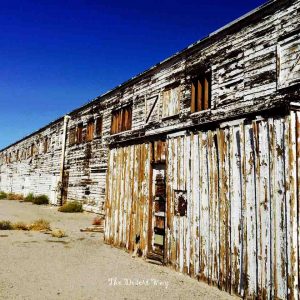
In the late 80s, NASA implemented its balloon launch program at Barstow-Daggett Airport but encountered challenges from the desert. The surface winds were the final nail in the coffin that forced NASA to abandon the site for launching stratospheric balloons.
The Landers earthquake in 1992 caused $1 million dollars in damage to three large hangars leased by the Army.
Today the Army has based several UH-60 Blackhawks there operating under the Fort Irwin National Training Center aviation company which on paper is based in Fort Irwin. It is also the regional weather information center.

When we originally visited the airport’s living quarters in 2005, people lived there and the place was abuzz with activity. When we visited again in 2013, the little Barstow-Daggett Airport community, although abandoned and boarded up by then, was in better shape than it would be just a mere three years later. Since then most of the dead trees have been cut down and fences torn down but not removed.
This is a village frozen in time. Many of the formerly boarded-up doors and windows are wide open or hang from creaking hinges in the relentless Mojave Desert winds. Dead and dying trees reach their scarred, barren arms towards the Heavens as if seeking mercy. It looks like a scene from some type a disaster. I couldn’t help thinking it would make for a great horror film location. Just add zombies, vampires, or serial killers.
It could also be used as training for troops, first responder’s or emergency personnel such as police and sheriff’s departments practicing barricade situations and active shooter scenarios.
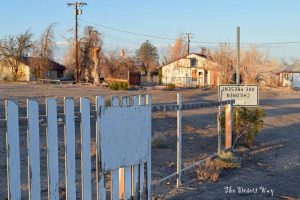
In March 2012, San Bernardino County and its division of airports began evicting residents from 17 housing units located on the grounds of Barstow-Daggett Airport. However, those being ousted from their properties were not in arrears on their rent payments.
Rather, the county was getting out of the landlord-residential tenant relationship due to the costs of maintaining the units as rentals and to clear the way for “transformation, renovation and modernization” of the premises to furnish quarters for aviation related uses and expand the military component of the facility.

The units were originally constructed in the 1940s by McDonnell-Douglas to house aircraft mechanics and technicians working there as defense contractors working at the base, including ones doing alteration work on World War II-era warplanes.
The homes were later used to house some military personnel stationed at the base. In the 1950s, the county acquired the residential properties and by the 1960s was renting out some of the residential units.

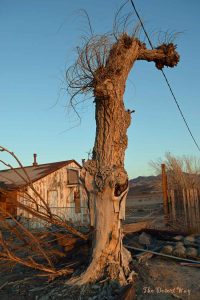
The county maintains a water system and sewage treatment system at the airport. The cost of supplying residents and other entities there with potable water ran to $225,000 per year, according to the county and the sewage plant costs roughly $55,000 per year to run and maintain.
The eviction of the residential tenants, however, did not obviate the need for the water and sewer systems, as flight and military related operations will continue to be carried out at the base. According to the county, administering the airport’s home rental program at the base entailed up to $120,000 worth of staff time and the county must maintain insurance that entailed premiums of approximately $2,000 per month.
The county claimed costs did not offset the $451 rent each residential household paid per unit monthly, which provided the county with a total of $92,000 per year.
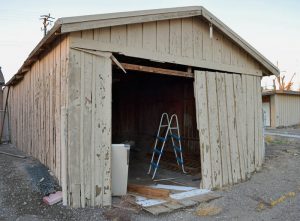
According to the county, rent on the units would have had to be increased to $2,400 per month to defray what it asserts is the $489,600 cost of remaining as landlord to the residents and maintaining the units themselves, along with the water and sewer systems.
Some of the residents and others have questioned whether the county’s assertion as to the actual costs of administration and maintenance of the water and sewer services are accurate and disputed the county will actually achieve savings by effectuating the evictions.

This tiny community is still holding its breath while awaiting the “transformation, renovation and modernization” the county promised in 2012.

There are still a handful of aviation-related businesses at the airport, including Daggett Aviation, which has contracts with the U.S. Army to provide services at the airport. The water and sewer systems needed to remain in place for use by the military, businesses and the county’s own office on the airport grounds.
In 2012, the county had no intention of closing down the airport, and was indeed looking to expand operations there. The board of supervisors had appropriated $2,444,000 for upgrading the electrical system on the airport runway and had already concluded the extension of one of the airport’s taxiways and put in new lighting for another taxiway.
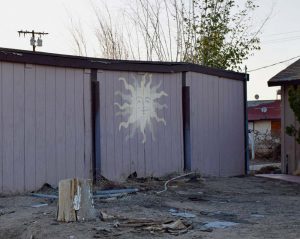
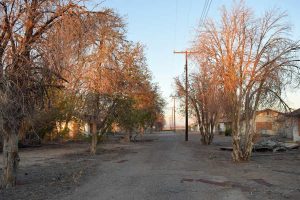



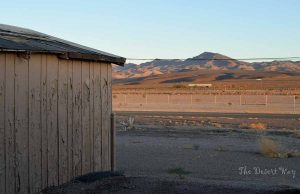
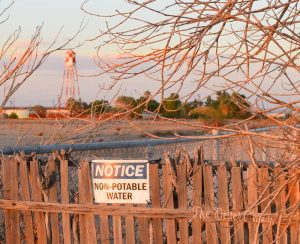
Nevertheless in 2012, county officials insisted they crunched numbers to determine that maintaining the housing program on the airport would cost more than four times what the rents generated.
The county maintained it had no obligation to provide those evicted with alternative housing and had offered each household $500 toward moving expenses while insisting that they vacate the premises by May 1, 2012.


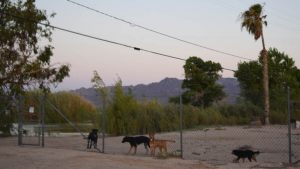
What does the future hold? As of 2016, there was a proposed 28-acre truck stop with an approved county conditional use permit located at Interstate 40 and Hidden Springs Road.

Citations and Recommended Resources:
http://cms.sbcounty.gov/airports/Airports/BarstowDaggett.aspx
http://www.digplanet.com/wiki/Barstow-Daggett_Airport
http://www.airnav.com/airport/KDAG
http://www.ntcaviationcompany.com/NTC_Aviation_Company/Newcomer_Info.html
http://stratocat.com.ar/bases/17e.htm
http://sbcsentinel.com/2012/03/residents-evicted-from-daggett-airport/
https://www.loopnet.com/Listing/16455848/Interstate-40-and-Hidden-Springs-Road-Daggett-CA/





That swimming pool was there before the 70’s I used to go swimming there in the ’50’s. There were several families that lived there and manned the airport and the light.
Thank you for the info, Beth! We appreciate your comments.
That area with the duck-pond the dogs are guarding receives routine maintenance by a bureaucrat in a county truck. His job? feed the ducks.
Nice gig if you can get it. 😀
We used to dus there from Newberry twice a week. That was some of the best times. I will never forget those long pop cycles . Wow really hate to see it look like that. The 50’s and 60’s was a great time to live in that area ( might even still be, haven’t been in years ) The pix were great but sad
Newberry Springs was quite the place to be in its hay day! Thanks for your comments, Dennis!
I am stunned and elated by this information. During the winter and spring of 1945 my father was sent to Daggett to “deactivate” the air field. For six months we lived in Barstow at the “Dale Cottage” housing. I have one photograph taken inside of a few of his fellow workers. I never knew where this airport was located in Daggett. I was in the fourth grade and had never seen any part of the country outside of the Los Angeles area. It was a different world to me and my much younger sisters. So happy to actually see pictures of where my father worked.
Thank you for sharing your memories with us, Geninne. Glad you were able to see where your Dad worked after all these years. I bet the desert was a shocker after being raised near a major metropolis. We hope it grew on you.
I lived in one of the houses in the late 60’s. Swam in the pool and played in the barracks. I thought is was great as a child ( 7th-8th grade ). Hate to see it in the shape it is in today. Lots of great memories.
That’s awesome, Kevin. Thanks for sharing your good memories with us.
I’m gonna assume the 28 acre Truck stop never happened.
I grew up there from 1986 to 1999 was the best place to grow up wish there was a way to restore it and bring it back
I use to swim here in the 70s and I had friends still living there in the beginning of the 80s
I also swam there in the 70s it was a nice place to swim
Something interesting here. Google Earth Streetview has a 2008 photo of the north side of Shed 4. The Google Earth Streetview van made it just east of Shed 4. You can swivel around and see the inside of Shed 4. At the time the shed to the east of Shed 4 was still standing. If you go down on old Hwy 66 it has some 2008 photos of when those houses were still occupied and all the trees there were still alive then too.
Here is the link to the Streetview photo of just northeast of Shed 4:
https://www.google.com/maps/@34.8603027,-116.7911249,3a,75y,159.48h,93.61t/data=!3m6!1e1!3m4!1sXG_oU9T4efdX9MZJB_LbKg!2e0!7i3328!8i1664
Here is the shot from the road to the south of that on-airport neighborhood when it was still occupied in 2008.
https://www.google.com/maps/@34.8545307,-116.7978499,3a,75y,339.39h,84.05t/data=!3m6!1e1!3m4!1sb3lmAhcXBBQWGj96HxgLMA!2e0!7i3328!8i1664
This shot is from the road on the north side of the neighborhood looking into it. The Google van didn’t enter the neighborhood but did drive the roads around it.
https://www.google.com/maps/@34.855477,-116.7974104,3a,60y,202.6h,91.04t/data=!3m6!1e1!3m4!1sbiZ5o5EY6HETT2jOtUZTTA!2e0!7i3328!8i1664
Thanks, Mark!
Thank you!